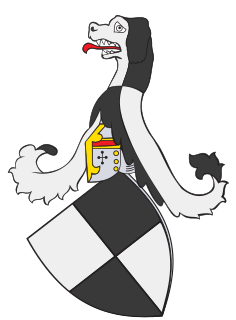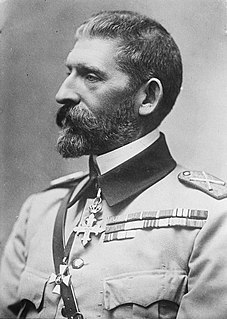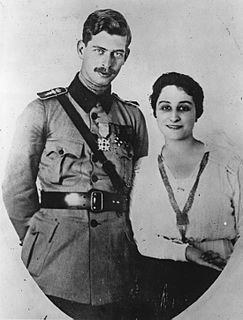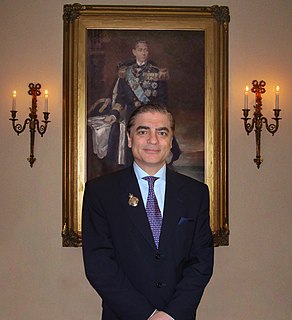
The House of Hohenzollern is a German former royal dynasty whose members were variously princes, electors, kings and emperors of Hohenzollern, Brandenburg, Prussia, the German Empire, and Romania. The family arose in the area around the town of Hechingen in Swabia during the 11th century and took their name from Hohenzollern Castle. The first ancestors of the Hohenzollerns were mentioned in 1061.

Michael I was the last King of Romania, reigning from 20 July 1927 to 8 June 1930 and again from 6 September 1940 until his forced abdication on 30 December 1947.

Hohenzollern-Sigmaringen was a principality in southwestern Germany. Its rulers belonged to the senior Swabian branch of the House of Hohenzollern. The Swabian Hohenzollerns were elevated to princes in 1623. The small sovereign state with the capital city of Sigmaringen was annexed to the Kingdom of Prussia in 1850 following the abdication of its sovereign in the wake of the revolutions of 1848, then became part of the newly created Province of Hohenzollern.

Ferdinand, nicknamed Întregitorul, was King of Romania from 1914 until 1927. Although a member of the Swabian branch of Germany's ruling House of Hohenzollern, Ferdinand sided against the Central Powers in World War I. Thus, at the war's end, Romania emerged as a much-enlarged kingdom, including Bessarabia, Bukovina and Transylvania, and Ferdinand was crowned king of "Greater Romania" in a grand ceremony in 1922. He died from cancer in 1927, succeeded by his grandson Michael under a regency.

Joanna Marie Valentina "Zizi" Lambrino was the first (morganatic) wife of the later King Carol II of Romania. They had one son, Carol, born in 1920, in Bucharest.

Prince Nicholas of Romania, later known as Prince Nicholas of Hohenzollern-Sigmaringen, was the fourth child and second son of King Ferdinand I of Romania and his wife Queen Marie.

Louis Ferdinand Victor Eduard Adalbert Michael Hubertus, Prince of Prussia was a member of the royal House of Hohenzollern and the pretender for a half-century to the abolished German throne. He was also noteworthy as a businessman and a patron of the arts.

Paul-Philippe Hohenzollern, also known as Prince Paul of Romania and Paul Lambrino, is the son of Carol Lambrino and Hélène Henriette Nagavitzine. His father was the elder son of King Carol II of Romania and Zizi Lambrino. Paul-Philippe claims that he and not Princess Margareta is the rightful head of the royal house of Romania.

Prince Radu of Romania is the husband of Margareta of Romania, head of the House of Romania and a disputed pretender to the former Romanian throne. On 1 January 1999, he was given the name, not title, of "Prince of Hohenzollern-Veringen" by Friedrich Wilhelm, Prince of Hohenzollern, the Head of the Sigmaringen branch of the Hohenzollern family. He has also called himself "Radu Hohenzollern-Veringen-Duda". Since 2007, when he had his legal name changed from "Radu Duda" to "Radu al României Duda", Radu no longer uses the name of Hohenzollern. The Fundamental Rules of the Romanian Royal Family, proclaimed by former King Michael I on 30 December 2007, gave Radu the title of "Prince of Romania", with the style of "Royal Highness", which King Michael had given him earlier on 5 January 2005.

Mircea Grigore Carol Hohenzollern, also known as Prince Mircea Grigore Carol al României according to his amended Romanian birth certificate or as Carol Lambrino, was the elder son of King Carol II of Romania.

Leopold, Prince of Hohenzollern was the head of the Swabian branch of the House of Hohenzollern, and played a fleeting role in European power politics, in connection with the Franco-Prussian War.
The line of succession to the former Albanian throne is an ordered list of those eligible to succeed to the headship of the Royal House of Albania, grand mastership of the dynastic orders and ascend the throne of Albania in the event the monarchy is restored. The native monarchy of Albania was deposed in 1939. The current head of the royal house is Leka (II), Prince of the Albanians.

Friedrich Wilhelm, Prince of Hohenzollern was the head of the Princely House of Hohenzollern for over 45 years.

The Kingdom of Romania was a constitutional monarchy in Central-Eastern Europe, ruled by a royal family that was a branch of the Hohenzollern dynasty. The kingdom existed from 1881, when Carol I of Romania was proclaimed king, until 1947, when the last king, Michael I of Romania, abdicated and the Parliament proclaimed Romania a republic. Soon after, upon the establishment of the constitution of 13 April 1948, Romania became a popular republic, a regime that lasted until 1989.

William, Prince of Hohenzollern was the eldest son of Leopold, Prince of Hohenzollern and Infanta Antónia of Portugal.

Princess Josephine Friederike Luise of Baden was born at Mannheim, the second daughter of Charles, Grand Duke of Baden and his wife, Stéphanie de Beauharnais. She was the mother of the first king of Romania. Through her younger daughter Marie, she is the ancestress of the Belgian royal family and the Grand Ducal family of Luxembourg.

Frederick, Prince of Hohenzollern was the eldest son of William, Prince of Hohenzollern and Princess Maria Teresa of Bourbon-Two Sicilies. He had a twin brother, Franz Joseph, Prince of Hohenzollern-Emden, who was born a few minutes after he was.

Johann Georg, Prince von Hohenzollern was a German prince, and through his marriage to Princess Birgitta of Sweden, was brother-in-law of King Carl XVI Gustaf of Sweden.

The Monarchy of Germany was the system of government in which a hereditary monarch was the sovereign of the German Empire from 1871 to 1918.



















